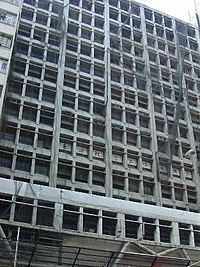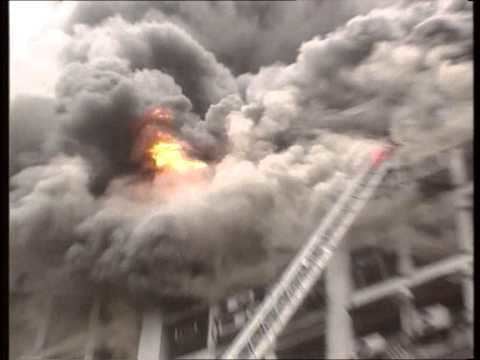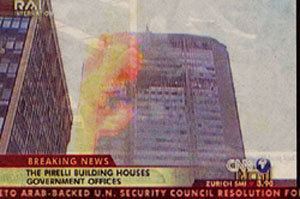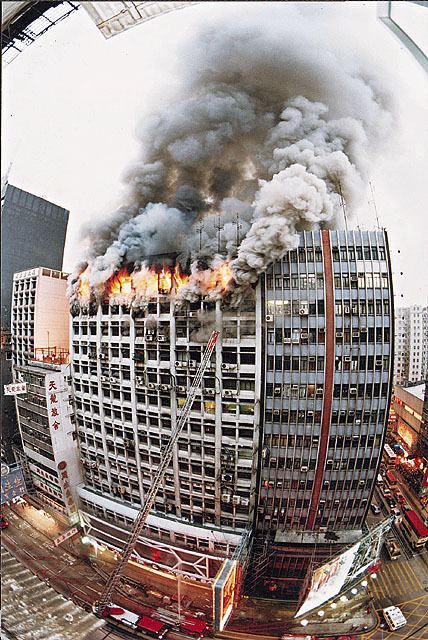Date 20 November 1996 Location Hong Kong | Location Kowloon, Hong Kong | |
 | ||
Similar Cornwall Court fire, 1996 Pat Sin Leng Wildfire, 2011 Fa Yuen Street fire, 2012 Lamma Island ferr, King's Cross fire | ||
Ray rudowski tvb news november 20th 1996 garley building fire yau ma tei
The 1996 Garley Building fire took place on 20 November 1996 in the 16-storey Garley commercial building (Chinese: 嘉利大廈) located at 232–240 Nathan Road, Jordan, Hong Kong. It was a catastrophe that caused the loss of 41 lives and 81 injuries. It is considered the worst building fire in Hong Kong during peacetime. The fire damaged the bottom two floors and the top three floors of the building, while the middle floors remained relatively intact.
Contents
- Ray rudowski tvb news november 20th 1996 garley building fire yau ma tei
- History
- Tenants
- Fire
- Rescue effort
- Aftermath
- Reconstruction
- References

History

The building was built in 1975 before the government introduced laws requiring all commercial buildings to install sprinkler systems. The land lot was bought by Kai Yee Investment Company Ltd in 1970 at a cost of HK$1.56 million (US$200,000). A subsidiary of China Resources, Chinese Arts & Crafts, acquired half the building –from the basement to the ninth floor –for HK$35.5 million in 1989.
Tenants

Fire

Welding was revealed to be the source of the fire. At the time of the fire, the Garley Building was undergoing internal renovation, during which new elevators were to be installed. One had been completely refurbished, with another almost completed; the other two elevator shafts in the building had had their elevators removed, and bamboo scaffolding installed within the shaft. The fire-resistant elevator doors were also removed to allow light into the elevator shaft for the welders.

The welding activity routinely triggered alarms from the building's smoke detectors, so much so that staff at the China Arts & Crafts store that occupied the bottom three floors had wrapped plastic around the fire alarms to muffle the sound. Furthermore, workers were found to have cut metal with a welder, contrary to building codes. Thus, when a stray piece of hot metal fell from the thirteenth floor, sparking a fire in the second floor lift lobby, no one paid much attention, believing that it was part of the normal welding activity. A welder discovered the fire, and alerted the fire department. A second emergency call would be made one minute later, when a dental assistant on the 13th floor discovered dense smoke in the hallway.

When firefighters first arrived at the scene ten minutes after the lower fire had started, the fire was rated at one-alarm. It was almost immediately raised to three-alarm at 4:59PM when heavy smoke impeded firefighters' process up higher floors. By the time reinforcements arrived, it was upgraded to four-alarm at 5:17PM because the 15th floor was on fire, and was upgraded again to five-alarm—the highest level in Hong Kong, at 7:15PM on that day.
The fire consumed the bamboo scaffolding; the open elevator shaft provided a source of fresh air, creating a chimney effect that eventually rose to the 13th floor, starting another fire there. Charred human remains were found on the 13th and 14th floors. A workshop run by Chow Sang Sang Jewellery that occupied two rooms on the 15th floor had 22 bodies.
Rescue effort
All in all, over 200 firemen and 40 engines were deployed. A UH-60 Black Hawk helicopter was also deployed to rescue people trapped on the roof, but quickly left after rescuing four people as it was feared that the rotating helicopter blades were making the fire worse. The role of the helicopter was later studied.
With the elevators unusable and the staircases impassable due to the smoke, firefighters had difficulty reaching the upper levels of the building, relying on four rescue ladders to rescue occupants who had opened the windows for fresh air. The flame was finally put out after 20 hours. In total 41 people had died; one firefighter was killed after plunging down an elevator shaft. Another person died several months later, never recovering from a coma resulting of the fire. Another 80 people were injured, including 14 firemen.
Aftermath
Hong Kong Governor Chris Patten urged legislators to speed up the passage of a bill aimed at upgrading the fire safety standards of some 500 premises across the territory. A special police team of 229 officers was brought in for the first time in 10 years to help with identifying the bodies.
A census was completed days after the incident and found there were 60,000 private buildings in the Hong Kong territory at the time, half of which were more than 20 years old. Of these, 723 were commercial. It was reported that more than 700 office blocks built 20-plus years earlier, when safety laws were more lenient, were potential deathtraps.
Much of the blame for this incident fell on the welders and occupants, who were not properly trained in fire drills and knew little about building evacuation procedures. As a result of the fire, building regulations were quickly revised to prevent this sort of disaster from occurring again. Since the revisions, there has not been a single year in which more than ten people have died from fires.
The Chow Sang Sang Jewellery Company, which lost 22 employees on the 15th floor, increased its relief fund to $8+ million. Each victim's family received an initial $180,000 and another sum equivalent to 17.8 months' basic salary.
Reconstruction
Following the fire, the Garley Building stood vacant and was not demolished until 2003, a delay attributed to challenges in locating the owners of the businesses that operated within it. China Resources Enterprise, the building's original landlord, initially proposed developing a "Ginza-style" shopping mall on the site. However, the plan was eventually revised in favor of constructing a new office building, a project that was finalized in 2007.
